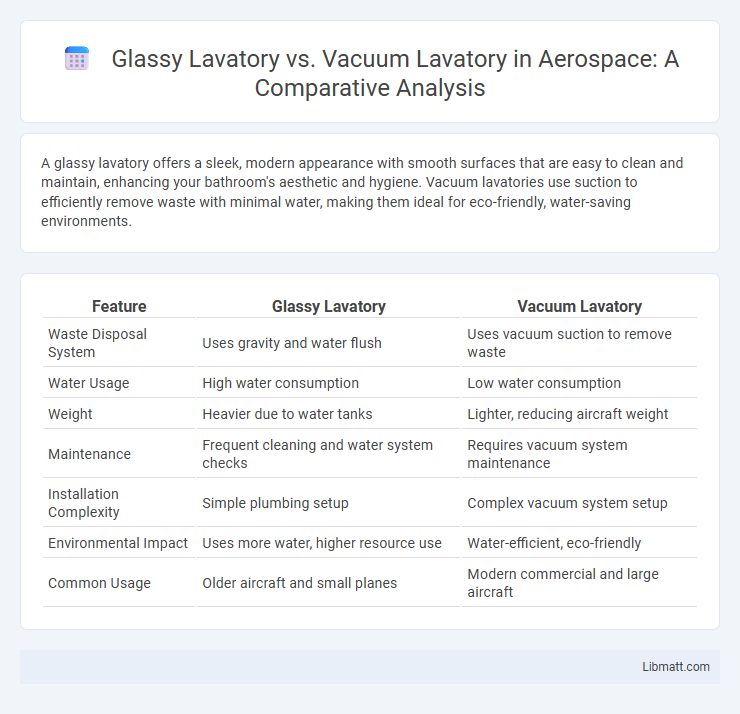A glassy lavatory offers a sleek, modern appearance with smooth surfaces that are easy to clean and maintain, enhancing your bathroom's aesthetic and hygiene. Vacuum lavatories use suction to efficiently remove waste with minimal water, making them ideal for eco-friendly, water-saving environments.
Table of Comparison
| Feature | Glassy Lavatory | Vacuum Lavatory |
|---|---|---|
| Waste Disposal System | Uses gravity and water flush | Uses vacuum suction to remove waste |
| Water Usage | High water consumption | Low water consumption |
| Weight | Heavier due to water tanks | Lighter, reducing aircraft weight |
| Maintenance | Frequent cleaning and water system checks | Requires vacuum system maintenance |
| Installation Complexity | Simple plumbing setup | Complex vacuum system setup |
| Environmental Impact | Uses more water, higher resource use | Water-efficient, eco-friendly |
| Common Usage | Older aircraft and small planes | Modern commercial and large aircraft |
Introduction to Modern Aircraft Lavatories
Modern aircraft lavatories utilize two primary systems: glassy lavatories featuring solid surface materials for durability and ease of cleaning, and vacuum lavatories that employ low-pressure suction to efficiently remove waste. Glassy lavatories offer a sleek, durable finish that resists stains and damage, enhancing passenger comfort and hygiene. Vacuum lavatories reduce water usage and minimize weight, contributing to improved fuel efficiency and reduced environmental impact on commercial aircraft.
What is a Glassy Lavatory?
A Glassy Lavatory is a type of aircraft lavatory featuring a smooth, non-porous glass surface that enhances cleanliness and hygiene by preventing bacteria and stains from penetrating the material. Unlike traditional Vacuum Lavatories, which use suction to remove waste through vacuum pressure, Glassy Lavatories rely on advanced coatings and materials for easy maintenance and durability. This innovative design reduces operational costs and improves passenger comfort by minimizing odors and improving sanitation.
What is a Vacuum Lavatory?
A vacuum lavatory uses suction technology to remove waste efficiently by creating a vacuum environment, significantly reducing water consumption compared to traditional glassy lavatories. This system operates at a lower pressure, requiring less plumbing infrastructure and enabling faster waste transport, making it ideal for aircraft, trains, and environmentally conscious buildings. Vacuum lavatories provide hygienic, odor-free operation and minimize maintenance costs due to their sealed and efficient waste disposal mechanism.
Key Differences: Glassy vs Vacuum Lavatories
Glassy lavatories use a traditional gravity-based system with water flowing to flush waste, while vacuum lavatories rely on suction to remove waste more efficiently. Vacuum lavatories consume up to 90% less water, making them environmentally friendly and cost-effective for aircraft and maritime use. Your choice depends on factors like water availability, maintenance complexity, and operational costs.
Hygiene and Cleaning Efficiency
Glassy lavatories feature smooth, non-porous surfaces that resist bacterial buildup, enhancing hygiene and simplifying cleaning protocols. Vacuum lavatories use suction to remove waste efficiently, reducing residue and limiting odor, but their complex mechanisms require regular maintenance to maintain hygiene standards. The glassy surface's ease of cleaning outperforms vacuum lavatories in minimizing microbial contamination and streamlining sanitation efforts.
Water and Waste Management
Glassy lavatories use a smooth, non-porous surface to minimize water usage by maximizing waste runoff efficiency, reducing the need for frequent flushing and conserving water resources. Vacuum lavatories utilize powerful suction to efficiently remove waste with minimal water per flush, significantly lowering overall water consumption and preventing waste buildup through sealed waste tanks. Your choice impacts sustainability, with vacuum lavatories offering superior waste containment and water savings ideal for water-scarce environments.
Environmental Impact and Sustainability
Glassy lavatories utilize tempered glass materials that are fully recyclable and reduce plastic waste, enhancing environmental sustainability. Vacuum lavatories operate using significantly less water--up to 90% less compared to traditional systems--thereby minimizing water consumption and wastewater production. Both systems contribute to sustainability, but vacuum lavatories offer greater water efficiency, while glassy lavatories prioritize recyclable materials and waste reduction.
Cost and Maintenance Considerations
Glassy lavatories typically have higher initial costs due to their specialized materials and aesthetic design but offer low maintenance with their easy-to-clean, non-porous surfaces that resist stains and odors. Vacuum lavatories, commonly used in aviation and marine applications, incur lower upfront expenses but require more frequent maintenance to ensure the vacuum system functions properly, increasing long-term operational costs. Cost-effectiveness depends on usage context, with glassy lavatories favored for high-end installations and vacuum lavatories preferred in environments prioritizing water conservation and waste management.
Passenger Experience and Comfort
Glassy lavatories offer enhanced passenger experience with sleek, modern designs that provide better lighting and a more spacious feel compared to traditional vacuum lavatories. Vacuum lavatories are more compact and efficient with water usage, but can sometimes produce noise and less comfortable spatial conditions. Your comfort improves notably with glassy lavatories as they combine aesthetics and functionality, elevating the overall perception of cleanliness and luxury.
Future Trends in Aircraft Lavatory Technology
Future trends in aircraft lavatory technology emphasize enhanced hygiene, sustainability, and passenger comfort. Glassy lavatories are gaining traction for their sleek, easy-to-clean surfaces that reduce microbial buildup, while vacuum lavatories continue evolving with more efficient wastewater management and lower water usage. Your next flight may feature cabins equipped with smart sensors and antimicrobial coatings, reflecting a shift towards greener, smarter lavatory solutions.
Glassy Lavatory vs Vacuum Lavatory Infographic

 libmatt.com
libmatt.com